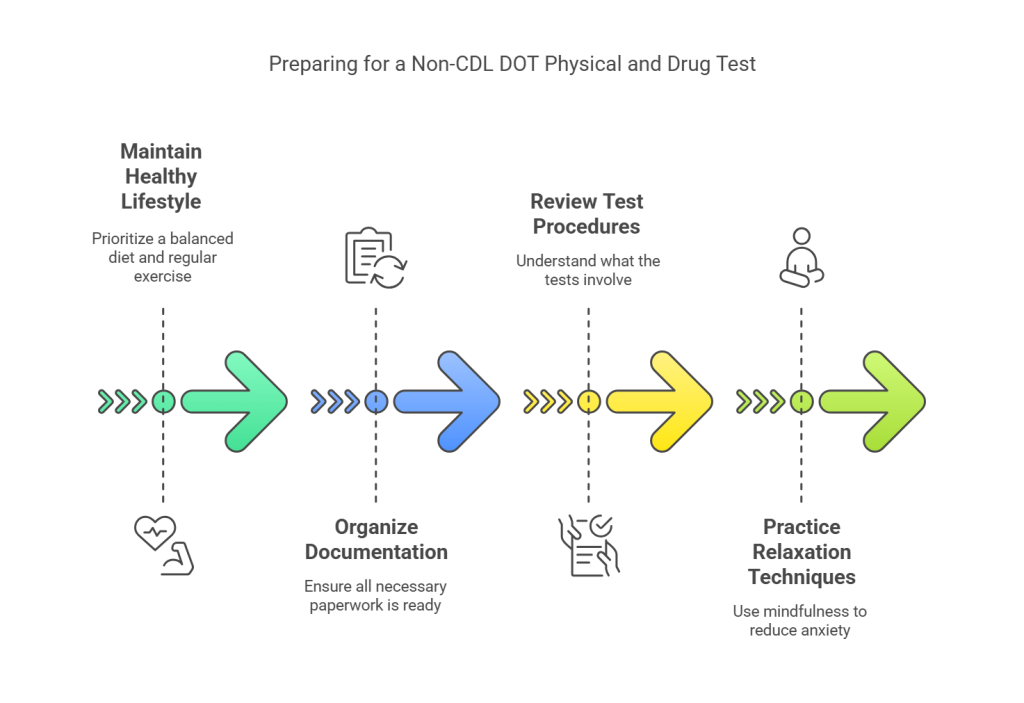Navigating the world of transportation logistics involves more than just knowing how to drive. For non-commercial drivers under Department of Transportation (DOT) standards, understanding the requirements for a non-Commerical Driver's License (CDL) DOT physical and drug test is crucial. Whether you’re a business owner ensuring compliance, an HR professional managing pre-employment processes, or a job seeker gearing up for new opportunities, this guide will provide detailed insights into what you need to know.
Key Takeaways
- The non-CDL DOT physical and drug test are vital for ensuring road safety and regulatory compliance across several industries.
- A non-CDL DOT physical confirms that drivers without a commercial license are medically fit to operate substantial vehicles safely.
- The DOT physical includes basic health checks and specific tests to identify any medical issues that could impair driving.
- DOT drug tests primarily use urine samples to detect substances, ensuring drivers adhere to legal safety standards.
- Preparation for these exams involves maintaining good health, organizing necessary documents, and understanding the requirements to prevent legal issues.
Introduction
Driving is just the tip of the iceberg when it comes to road safety and job compliance. Behind the wheel, the real safety nets are the DOT physical and drug tests. These exams play a crucial role in maintaining not just individual health, but public safety on the road. This article is for business owners, HR professionals, and job seekers in industries like Staffing, Healthcare, and Transportation. We'll cover the exam details, types of drug tests, and effective preparation. Stick around—whether you're hiring or aspiring, understanding these essentials will keep you compliant and ready for the road ahead.
EXPERT INSIGHT: Safety, whether on the road or in general, is paramount. As an HR leader, I understand that our programs and processes are vital for everyone—not just a select few—and they definitely shouldn't be left to gather dust. These guidelines are here to ensure fairness, protect the company's reputation, and promote a culture of accountability. Ultimately, they safeguard people's lives. Drivers, read on to better prepare and stay compliant as HR and business leaders ensure programs are in place for everyone's safety. - Emile Garcia, SHRM-SCP, CHRP, CHRBP
Understanding the Non-CDL DOT Physical
Navigating the landscape of non-commercial driving often brings us to the doorstep of the non-CDL DOT physical—an essential checkpoint in ensuring both safety and regulation compliance on the roads. So, what exactly is this exam, and why is it such a pivotal condition for drivers outside the commercial scope?
The non-CDL DOT physical is a medical examination required by the Department of Transportation for drivers who do not have a commercial driver’s license (CDL). It confirms that drivers are medically fit to operate vehicles, even those that do not require a CDL, and helps prevent accidents due to medical issues.
When it comes to regulatory frameworks, the DOT sets specific standards that need to be met by non-commercial drivers. These standards ensure that the roads remain safe, and those who drive are within health guidelines that prevent accidents or health-related incidents while on duty. This standard is vital for roles where driving is a regular part of the job, such as delivery drivers, city service technicians, and others who may need to drive substantial vehicles like large vans or smaller transport vehicles that don't necessitate a CDL.
The need for this physical varies across industries, but it generally applies to roles involving regular vehicle operation. This includes healthcare, construction, and utility services. Understanding who must comply is crucial for businesses in maintaining their compliance shield, protecting them from legal repercussions, and ensuring the safety of their personnel and the public.
Components of the DOT Physical Examination
The DOT physical exam is designed to assess whether a driver is physically and mentally capable of safely operating a vehicle. This assessment includes several key components to ensure a comprehensive evaluation:
General Health Assessment
During the exam, the medical examiner will check your blood pressure, vision, hearing, and overall medical history. These basic assessments help identify any pre-existing conditions that might impair your ability to drive. Good vision and hearing are crucial for safe driving, and controlled blood pressure is a must to prevent sudden health issues while on the road.
Specific Tests
Based on initial findings, more specific tests might be conducted. Cardiovascular evaluations are critical, especially for those with a history of heart issues, as they assess the heart's ability to withstand stress. Additionally, a urinalysis is performed, which can reveal underlying conditions like diabetes. These tests collectively ensure that there are no hidden medical concerns that could pose a risk while driving.
Documentation
Accurate record-keeping is critical during a DOT physical. You’ll need to fill out the Medical Examination Report, a detailed document covering your medical history and test results. Keeping this information up-to-date ensures that you're in compliance with DOT regulations and provides vital records if there's ever a dispute about your health status.
In sum, the DOT physical isn't just a formality—it's a safeguard. Whether you're backing up in a loading dock or navigating a busy freeway, knowing you’re medically certified gives peace of mind to you, your employer, and everyone else on the road.
The Drug Test: What to Expect
When it comes to DOT drug testing, simplicity underpins the process, yet there's enough variety to keep things interesting. You’ll typically encounter a urine drug test, the standard issue in this world of safety compliance. It's straightforward, quick, and does the job for detection. But testing doesn’t stop there. Hair tests, while less common, serve up a longer detection window, offering insights stretching back months. Saliva tests pop up in certain scenarios, providing a short-term snapshot of what substances have tangoed through your system. Blood tests? Rare in this setting, but they exist—more invasive, more immediate.
The lineup of substances being screened is predictable yet crucial. Marijuana, cocaine, opiates, amphetamines, and PCP form the usual hit list, the quintet that stands between you and a clean report. Each substance has its unique linger time in the body, so knowing the lay of this biochemical land helps you sail through.
Legally, the DOT's rules aren’t just suggestions; they’re the law of the land, dictating the manner in which tests are conducted to ensure fairness and consistency. Adhering to these regulations isn’t just about keeping on the right side of legality—it's your ticket to demonstrating professionalism and commitment to safety, all while avoiding any messy legal entanglements.
How to Prepare for Your Non-CDL DOT Physical and Drug Test
Getting ready for a non-CDL DOT physical and drug test doesn’t have to be a daunting task. By taking a few practical steps, you can make the process smoother and reduce any unease.
Health Preparations
Start with the basics: maintain a healthy lifestyle. Prioritize a balanced diet rich in fruits, vegetables, lean proteins, and whole grains. Stay hydrated and get enough sleep, especially in the days leading up to your test. Regular exercise can also help keep your blood pressure and weight in check. If you're on any medications, ensure they are correctly managed and in line with DOT guidelines. Staying on top of these factors not only prepares you for the physical but also promotes long-term health. Additionally, reducing your caffeine and sodium intake can positively impact your blood pressure.
Documentation Readiness
Documentation is everything. Have all required paperwork in order, including any previous medical records that might be relevant. Bring a list of any prescription medications you're taking as well as over-the-counter drugs or supplements. Being organized with your documentation ensures a smooth examination process and helps the healthcare professional conduct a thorough assessment. It's also helpful to bring any recent test results, such as blood work, to provide a complete picture of your health.
Mental Preparation
Let’s face it: tests can be anxiety-inducing. However, knowing what to expect can ease your mind. Review what the physical and drug test will entail, either through resources like this article or by speaking with colleagues who have been through the process. Visualize yourself going through each step calmly and confidently. Deep breathing and mindfulness exercises can also keep anxiety at bay. Remember, the goal isn't perfection but preparation. Relax, stay informed, and the tests will seem far less daunting. Preparing mentally is as crucial as the physical and documentation aspects.

Legal and Compliance Issues
Navigating the legal landscape of non-CDL DOT requirements can feel like cruising through a foggy coastline. The key DOT regulations revolve around ensuring that all drivers maintain a standard of physical capability and sobriety, securing a safer environment on the roads. Compliance isn’t just a box to tick—it's the backbone that supports operational integrity. For non-CDL drivers, understanding these regulations is as important as the road itself.
Different industries bring their own twists to the wheel. For example, healthcare settings might prioritize additional health screenings, while retail might stress scheduling logistics around tests. Regardless, the foundational DOT standards remain vital, ensuring uniformity and fairness in the application of these rules.
Drivers and employers alike have rights and responsibilities. Drivers, for example, have the right to confidentiality regarding their test results, and the expectation of non-discrimination based on those results. Employers, on the other hand, carry the torch of responsibility for maintaining up-to-date compliance and ensuring fair practices in implementing DOT standards. Keeping the lines clear prevents legal snafus and promotes a culture of safety and reliability.
FAQs
Do all non-CDL drivers need a DOT physical and drug test?
Not all non-CDL drivers are required to undergo a DOT physical and drug test. The necessity depends on the type of vehicle being operated and the industry requirements. For instance, drivers transporting certain hazardous materials, or those driving vehicles over a certain weight threshold, may require certification regardless of a CDL.
How often must DOT physicals and drug tests be conducted?
DOT physicals are typically valid for up to 24 months; however, the certifying medical examiner might issue a certificate for less than two years if there are health concerns that need to be monitored. Drug tests are generally mandated pre-employment and may be conducted randomly, post-accident, or upon reasonable suspicion. It's crucial for both employers and employees to stay updated on these requirements to ensure compliance with federal regulations. Regular monitoring helps maintain the safety and reliability of the workforce.
What happens if a test is failed?
Failing a DOT physical or drug test can have significant repercussions. If a driver fails the physical, they cannot receive the Medical Examiner's Certificate needed to legally operate their vehicle. Failing a drug test often leads to suspension or termination and may require completing a Substance Abuse Program before returning to duty. Failing either test can also impact the driver's future job prospects, as employers prioritize hiring individuals with clean records. Addressing health issues proactively and understanding the consequences of failed tests is essential for maintaining a career in driving.
Can alternative therapies affect drug test results?
Yes, certain alternative therapies and herbal supplements may affect drug test results. Substances like CBD, which may contain trace amounts of THC, can trigger positive test results. It is crucial to disclose any supplements or therapies to the medical examiner and testing personnel beforehand to avoid misunderstandings.
Conclusion
The non-CDL DOT physical and drug test serve as critical elements in safeguarding road safety and regulatory compliance. These examinations not only ensure that drivers meet health and safety standards but also maintain the integrity of operations within various industries. By understanding the requirements and processes involved, businesses and individuals can stay ahead of compliance mandates and contribute positively to overall road safety.
Being proactive is essential. Companies should routinely verify their practices align with DOT regulations, while individuals should remain informed and ready for these assessments. Knowledge and preparation can ease the procedural burdens and foster a smoother journey through the professional landscape.
Ultimately, maintaining good health and compliance doesn't just fulfill legal obligations—it underscores a commitment to safety and responsibility on the road. Embrace these requirements as opportunities to excel in your roles, ensuring both personal well-being and the safety of others.
Additional Resources
When diving deeper into the intricacies of non-CDL DOT physical and drug test requirements, having a handy list of resources can streamline your efforts. For tailored insights into industry-specific hiring practices and background checks, check out GCheck's Blog. This resource offers articles that cater to nuances across different sectors, equipping you with practical knowledge to stay compliant and effective.
For those seeking broader guidance on hiring standards, the Department of Labor is a go-to comprehensive resource. It offers detailed explanations of hiring practices and legal guidelines, ensuring that both employers and employees are well-versed in the latest regulatory requirements.
Additionally, the Professional Background Screening Association is an invaluable resource for understanding best practices in background screening. Their site is packed with research and standards that are crucial for employers looking to make informed hiring decisions. Whether you're new to the field or a seasoned professional, these resources will provide the clarity and support needed to navigate the complexities of non-CDL DOT requirements.
Still have questions?
Get in touch with our team today for a personalized demo and discover how our tailored volume pricing and packages can drive results for your business!
How useful was this page?*
Note: your comments are anonymous. We use them to improve the website. Do not include any personal details.
Visit our FCRA Compliance Tool or leave a message here if you need a response.
From the blog Explore the GCheck Content Hub

How to Verify a High School Diploma for Employment in 2026: A Complete Guide for HR Teams
30 Dec, 2025 • 21 min read
Background Check Compliance 2026: Navigating New State Laws and Federal Requirements
30 Dec, 2025 • 21 min read
Education Verification in 2026: A Complete Guide for Employers and Job Seekers
30 Dec, 2025 • 22 min readThe information provided in this article is for general informational and educational purposes only and should not be construed as legal advice or a substitute for consultation with qualified legal counsel. While we strive to ensure accuracy, employment screening laws and regulations—including but not limited to the Fair Credit Reporting Act (FCRA), Equal Employment Opportunity Commission (EEOC) guidelines, state and local ban-the-box laws, industry-specific requirements, and other applicable federal, state, and local statutes—are subject to frequent changes, varying interpretations, and jurisdiction-specific applications that may affect their implementation in your organization. Employers and screening decision-makers are solely responsible for ensuring their background check policies, procedures, and practices comply with all applicable laws and regulations relevant to their specific industry, location, and circumstances. We strongly recommend consulting with qualified employment law attorneys and compliance professionals before making hiring, tenant screening, or other decisions based on background check information.


